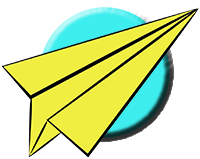Pike Paper Airplane How to Make
Pike Paper Airplane How to Make
Instructions
1. Fold the paper in half diagonally. The left point of the new crease should be at the lower left corner of the paper and the right point should be at the upper right corner. This crease can be difficult to make accurately so take your time. Unfold after the crease has been made.
2. Fold the paper in half along the other diagonal. The left point of the new crease should be at the upper left corner of the paper and the right point should be at the lower right corner. Unfold after the crease has been made.
3. Flip the paper over.
4. Fold the paper exactly in half about its long edge. Unfold after the crease has been ma
5. Flip the plane over.
6. Pop the points on the left and right edges of the paper up about the existing diagonal creases, bringing them in and down towards the bottom edge of the paper. Bring to the top edge of the paper down so it lines up with the bottom edge.
7. Make a crease to fold the right edge of the paper up towards the nose tip. Bring the left and right points of the first layer of the wing tips in towards the center so they hit the newly formed crease. Line up the diagonal edges of the wing tips with the new crease.
8. Fold the upper left point over towards the middle. The new crease should be even with the left diagonal edge.
9. Fold the upper right point over towards the middle. The new crease should be even with the right diagonal edge.
10. Fold the tip of the nose down so the top point is centered. The left and right points of the new crease should be at the top points of the previously folded flaps.
11. Fold the top edge down so the top edge lines up with the horizontal crease in the middle of the paper.
12. Flip the plane over and rotate it around so the previously crafted flaps are underneath and the nose points to the right.
13. Fold the plane exactly in half. Be sure to line up the wing flaps for good balance.
14. Flip the plane over so the wing flaps are down and pointed to the right.
15. Make a crease for the first small wing flap. The right point of the new crease should be where the top-most flap hits the back edge of the paper and the left point should be at the left middle corner.
16. Rotate the plane around so the nose points to the right and the wing flaps are up.
17. Make a crease for the first wing flap. The left point of the crease should be at the top point of the fuselage and the right point should be about one finger width up from the base of the fuselage.
18. Make a crease for the first wing tip. The crease should match the one directly beneath it which was made for the first small wing flap.
19. Fold the wing tip flap back over on the top of itself. The left point of the new crease should be at the center line crease and the right point should be about one-half a finger width down from the center line.
20. Flip the plane over and rotate it around so the first wing flap is underneath and the nose points to the left.
21. Make a crease for the second small wing flap. The right point of the new crease should be where the top-most flap hits the back edge of the paper and the left point should be at the left middle corner.
22. Make a crease for the second wing flap. Be sure to line up the wing flaps for good balance.
23. Fold the wing tip flap back over on top of itself. Be sure to line up the wing tip flaps for good balance.
24. Open up the wings and the small wing flaps and adjust all of the angles so they are even. The plane is now upside down. The main dihedral angle with the body should be flat and the ends of the wings should be parallel with this angle. The flaps on the underside should be vertical to slightly outward.
Launch with a medium throw at a slight up angle. There are many surfaces and angles to experiment with on this craft. When well trimmed, it will do long and straight flights. A hard throw produces unpredictable results.
